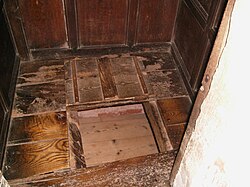Boscobel House
Boscobel House is a house on the Shropshire/Staffordshire border, near Wolverhamptonand Albrighton, England. It was built around 1632 when landowner John Gifford of White Ladies Priory turned a farmhouse into a hunting lodge. Charles II famously hid in a tree at the Boscobel House to escape discovery by Parliamentary soldiers after the Battle of Worcester in 1651. The tree became known as the Royal Oak
42 days after the Battle of Worcester, Charles escaped to France on a coal ship called Surprise. Nine years later, Charles ll was invited back to England to become king. In 1660, he came back to England to be the king and Charles named that day "Oak apple day".
Boscobel House Media
A descendant of the Royal Oak at Boscobel House
Alleged priest hole on the first floor of Boscobel House, at present in a bedroom cupboard. Its authenticity is open to challenge.
Priest hole on the second floor. At present it is at the top of a staircase, but the stairs were a few feet to the left in the 17th century.
The restored parterre garden, behind the 17th-century house constructed by John Giffard.
Frontage of the 16th-century farm, adjoining the 19th-century structure, seen in the background. The older building is genuinely timber framed, although the outer skin has been replaced with brick.
The wattle and daub construction of the 16th-century building, still exposed where it is partitioned between the dairy and entrance hall.
16th-century timber framing seen inside the entrance hall, formerly part of an undivided 16th-century hall.
Related pages
Other websites
- BBC on Boscobel House
- English Heritage entry: Boscobel House
- Roland Film's Documentary on the Restoration of Boscobel House
- Postcard images from a personal site Archived 2004-08-06 at the Wayback Machine








